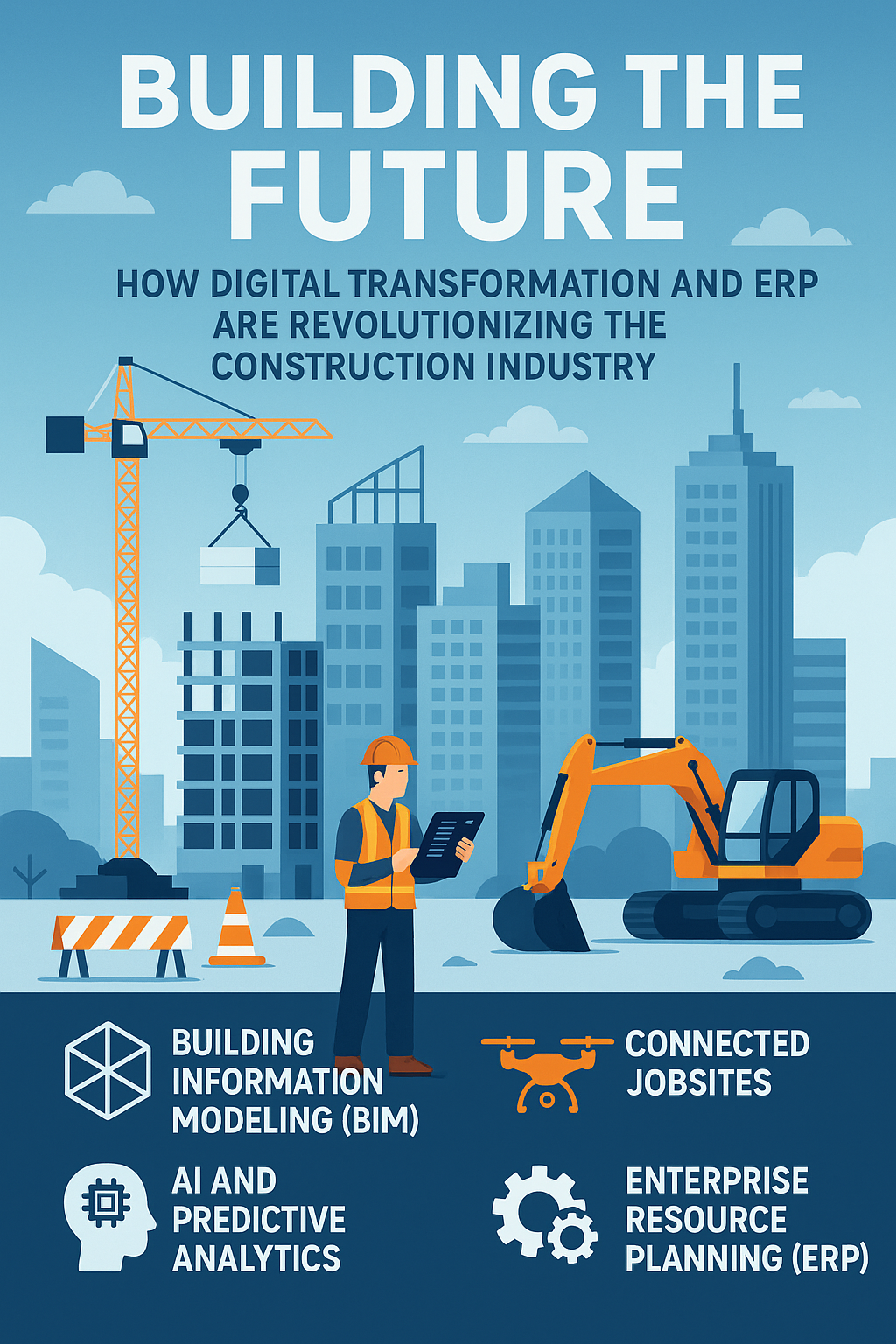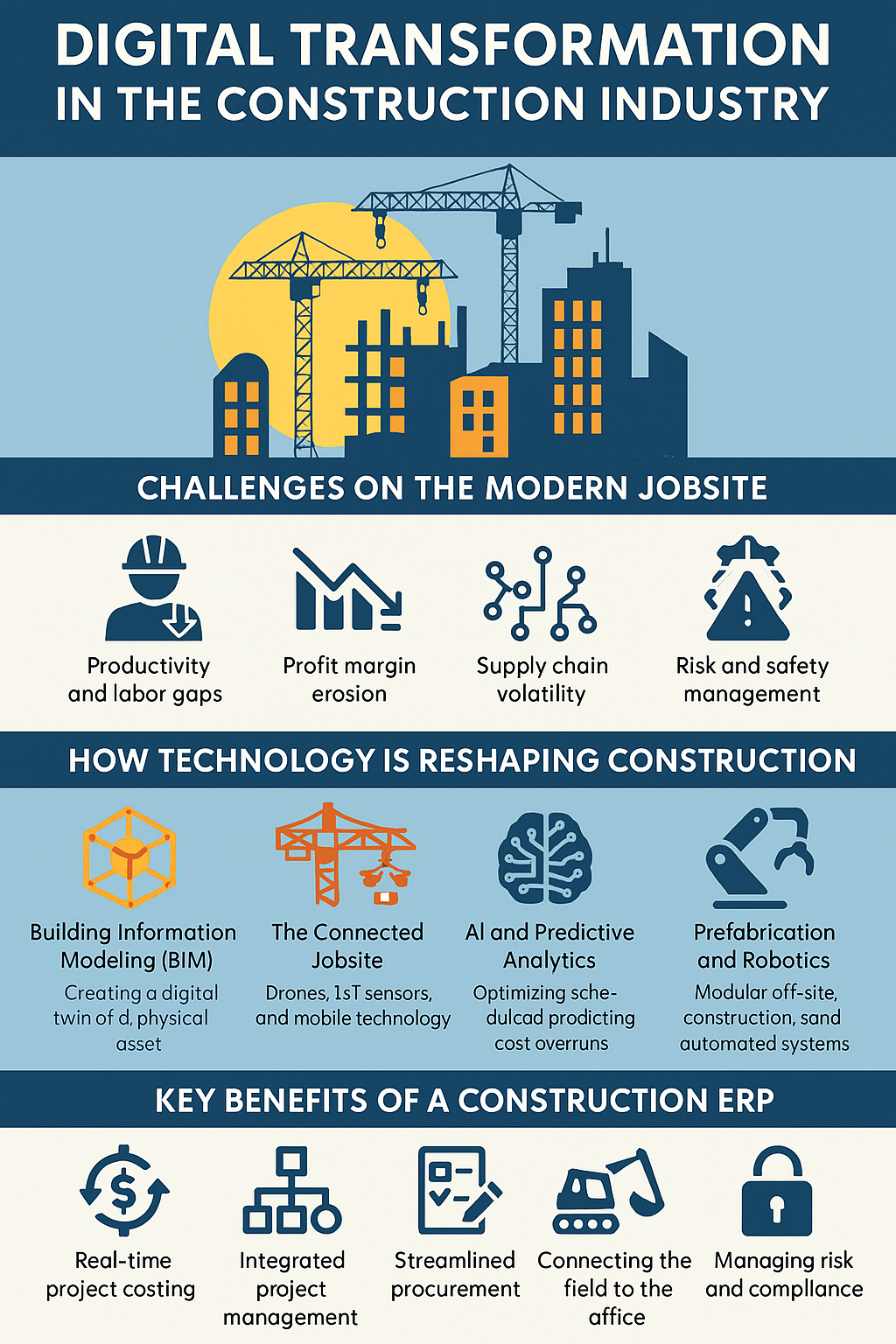Building the Future: How Digital Transformation and ERP are Revolutionizing the Construction Industry in 2025
2025-08-06 · By Anil Kancharla · 7 min read
❤️ 0 Likes · 👁️ 0 Views
 AI-generated image for illustration purposes only.
AI-generated image for illustration purposes only.
Building the Future: How Digital Transformation and ERP are Revolutionizing the Construction Industry in 2025
 AI-generated image for illustration purposes only.
AI-generated image for illustration purposes only.
Building the Future: How Digital Transformation and ERP are Revolutionizing the Construction Industry in 2025
Anyone driving through a city today can see it: cranes punctuate the skyline, and new projects rise from the ground at a relentless pace. The construction industry is booming, the engine of our city's growth. Yet, beneath this powerful exterior lies a paradox. For decades, construction has been one of the least digitized sectors, plagued by stagnant productivity, razor-thin profit margins, persistent labor shortages, and volatile supply chains.
The old way of building—reliant on paper blueprints, siloed teams, and reactive problem-solving—is no longer sustainable. The future of construction, and the key to unlocking profitability and resilience, is being forged in the digital world. We are in the midst of a profound digital transformation, a revolution that is turning job sites into connected, data-driven ecosystems. At the very center of this transformation, acting as the command center for every project, is modern Enterprise Resource Planning (ERP) software.
This in-depth blog post will explore the state of the modern construction industry, uncover the immense opportunities of its digital evolution, and provide a comparative analysis of leading ERP solutions designed to help builders, contractors, and engineers construct a more profitable future.
The Foundation of Change: Challenges on the Modern Jobsite
While the end products are modern marvels, the processes behind them have been slow to evolve. As of 2025, construction firms are grappling with a set of deeply entrenched challenges:
- Productivity and Labor Gaps: The industry continues to face a critical shortage of skilled labor. This, combined with historically low productivity growth, means projects take longer and cost more than they should.
- Profit Margin Erosion: Fierce competition, fluctuating material costs, project delays, and costly rework constantly threaten already thin profit margins. In construction, controlling costs is not just important; it's everything.
- Supply Chain Volatility: The "whiplash" effect from post-pandemic disruptions is still being felt. Unpredictable material availability and pricing make accurate bidding and scheduling incredibly difficult.
- Disconnected Teams and Data Silos: A typical project involves a complex web of owners, architects, engineers, general contractors, and dozens of subcontractors. Information is often trapped in separate systems, spreadsheets, or even on paper, leading to poor communication, errors, and disputes.
- Risk and Safety Management: Job sites are inherently dangerous environments. Ensuring worker safety and complying with complex regulations is a top priority, and failures can have devastating human and financial consequences.
The Digital Blueprint: How Technology is Reshaping Construction
Digital transformation provides a powerful toolkit to address these challenges head-on, turning disconnected job sites into intelligent, integrated environments.
-
Building Information Modeling (BIM): The Digital Foundation BIM is far more than a 3D model; it's the creation of a digital twin of a physical asset. This data-rich model becomes the single source of truth for the project, allowing teams to identify design clashes before construction begins (clash detection), visualize construction sequencing (4D BIM), and embed cost data into every component (5D BIM). It's the blueprint for the entire digital ecosystem.
-
The Connected Jobsite: Drones, IoT, and Mobile Tech The job site itself is becoming intelligent.
- Drones: Conduct topographic surveys in hours instead of weeks, monitor construction progress against the BIM model, and perform safety inspections in hard-to-reach areas.
- IoT Sensors: Placed on heavy equipment, they stream telematics data for predictive maintenance, preventing costly breakdowns. Placed on materials, they track location and usage. Embedded in concrete, they monitor curing temperatures.
- Mobile Technology: Tablets and ruggedized smartphones put BIM models, daily logs, change orders, and safety checklists directly into the hands of field crews, connecting the field to the office in real-time.
-
AI and Predictive Analytics Artificial intelligence is moving from a futuristic concept to a practical tool. AI algorithms can analyze historical project data to predict potential cost overruns and schedule delays, optimize resource allocation, and identify high-risk safety scenarios from job site photos and videos.
-
Prefabrication, Modular Construction, and Robotics By moving parts of the construction process off-site into controlled factory environments, companies can improve quality, speed up timelines, and enhance worker safety. This trend is accelerated by robotics, which can automate repetitive tasks like welding, bricklaying, and material handling.
The Command Center: Why ERP is the Single Source of Truth
With a flood of data coming from BIM models, drones, field apps, and equipment sensors, how does a construction company manage it all? How does a project manager know if they are really on budget today? This is the mission-critical role of an Enterprise Resource Planning (ERP) system built for construction.
A construction ERP integrates every aspect of the business—from accounting and project management to procurement and payroll—into a single, unified platform. It breaks down data silos and provides real-time visibility into the health of every project.
Core Benefits of a Construction ERP:
- Real-Time Project Costing and Financial Control: This is the heart of a construction ERP. It allows companies to track actual costs (labor, materials, equipment, subcontractors) against the budget in real-time, providing immediate insight into project profitability and enabling proactive course correction.
- Integrated Project Management: The ERP serves as the central hub, connecting financial data with project schedules, resource allocation, and critical documents like RFIs (Requests for Information), submittals, and change orders.
- Streamlined Procurement and Supply Chain: Manage purchase orders, track material inventory across multiple job sites, and control supplier and subcontractor contracts and payments from a single system.
- Robust Equipment and Asset Management: Track the location, usage, maintenance schedules, and costs associated with every piece of heavy equipment to maximize utilization and prevent costly downtime.
- Connecting the Field to the Office: Mobile integration allows field staff to submit timecards, daily reports, and expense receipts directly into the ERP, eliminating manual data entry, reducing errors, and accelerating billing cycles.
- Managing Risk, Compliance, and Payroll: Handle complex construction payroll (including union and certified payroll), manage subcontractor compliance (like insurance certificates), and maintain a clear audit trail for every transaction.
Choosing Your Toolkit: A Look at Leading Construction ERPs in 2025
The ERP market for construction includes global giants and deeply specialized providers. Choosing the right one depends on a company's size, complexity, and specific needs.

Building a Stronger Future
The construction industry is at a watershed moment. The challenges are significant, but the digital tools to overcome them have never been more powerful or accessible. The companies that will build the skylines of tomorrow are the ones that are building a digital foundation today. They are the ones who understand that real-time data is as critical as concrete and steel.
By embracing digital transformation and anchoring their operations in a robust, construction-specific ERP system, firms can break the cycle of low productivity, gain control over their project costs, and build a more resilient, safe, and profitable business for the future.
💌 Enjoyed this article?
If you found this post valuable, subscribe to my newsletter for more insights on digital transformation, AI, and business innovation.
👉 Subscribe to the newsletterOr let’s connect on LinkedIn — I share weekly content that’s practical for CIOs, CFOs, and transformation leaders.
🔗 Connect with me on LinkedIn